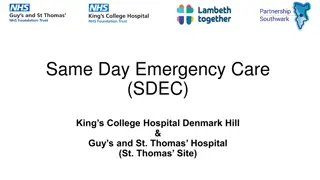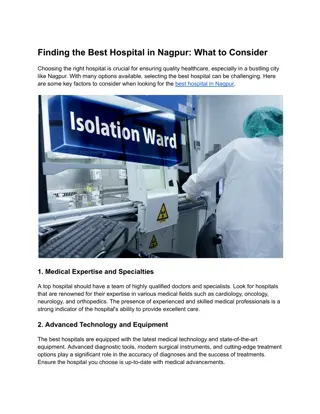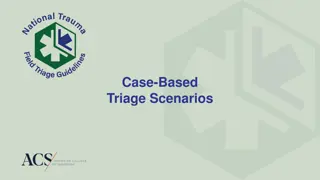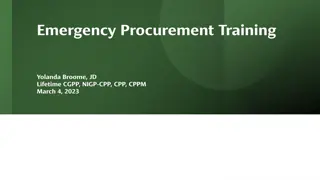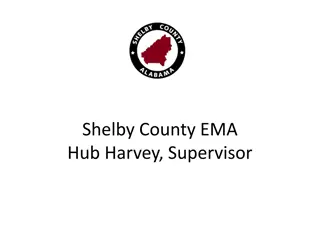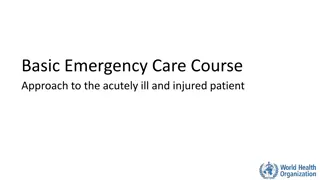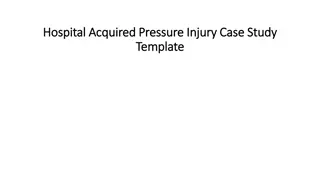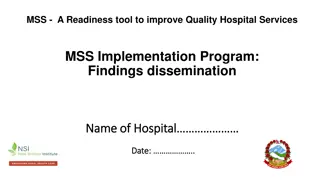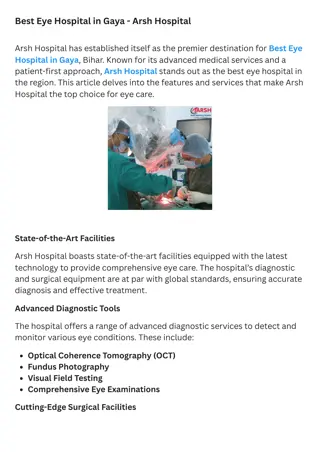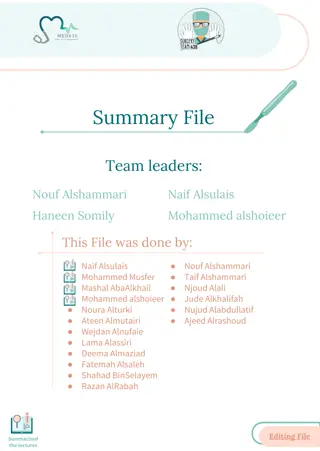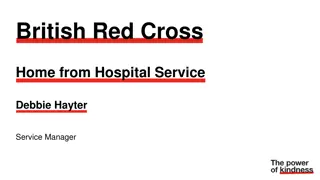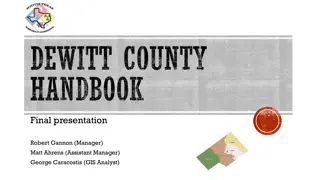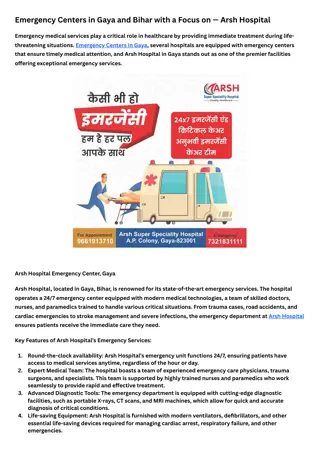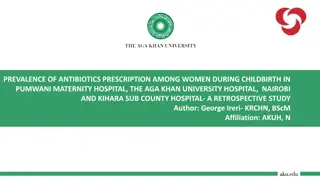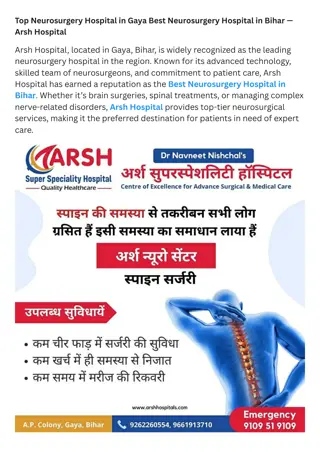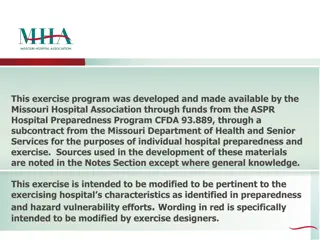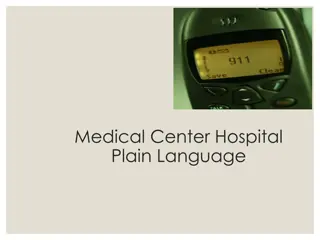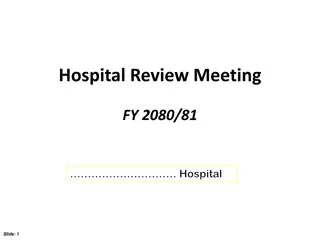ABCDE Approach for Initial Assessment in Emergency Situations at Kacheliba Sub-County Hospital
Adapted from European standards, the ABCDE approach is a systematic method for assessing severely ill patients, focusing on Airway, Breathing, Circulation, Disability, and Exposure. This comprehensive guide provides key concepts and practical strategies for managing emergencies effectively, emphasizing patient stabilization and communication with colleagues. The approach is tailored to the resources available at Kacheliba Sub-County Hospital, ensuring prompt and appropriate interventions for various conditions.
Download Presentation

Please find below an Image/Link to download the presentation.
The content on the website is provided AS IS for your information and personal use only. It may not be sold, licensed, or shared on other websites without obtaining consent from the author. Download presentation by click this link. If you encounter any issues during the download, it is possible that the publisher has removed the file from their server.
E N D
Presentation Transcript
EDIT This CME about initial assessment/ABCDE was originally held on flip chart, the presentation was made to send out as study material afterwards. The ABCDE algorithm has been adapted for the resources available at Kacheliba Sub-County Hospital and is therefor limited compared to european standards.
CME on initial assessment in emergencies (ABCDE) Dr Siri Maartensson Kacheliba Sub-County Hospital 12/09/2023
ABCDE-approach Airway, Breathing, Circulation, Disability, Exposure Worldwide, standardised, systematic approach for initial assessment of the severly ill patient regardless of cause of illness (medical, surgical, trauma etc) Assess and treat acute symtoms stabilizing patient for further investigation and diagnosing Same principal wherever you are but of course resources and equipment that vary
Key concepts of ABCDE Manage most lethal condition first (i.e an obstructed airway will kill the patient quicker than most bleedings) Asses possible intervention re-assess to see if action helped Communicate with your colleagues! Give direct instructions to specific person, don t shout out orders into the room. Use SBAR or other tool for report about patient (Situation, Background, Assessment, Recommendations)
Following approach with ABCDE it adapted for Kacheliba Sub-County Hospital. In settings with other equiment/resources the interventions may be different (i.e endotracheal intubation if obstructed airway)
Airway - Examination An obstructed airway will kill the patient within minutes! Talk to the patient responsive? If patient if talking airway is open, sufficient blood pressure for cerebral perfusion. Look In mouth - Loose objects to be removed? Suction needed? Chest movement Absent? Abdominal breathing ( see-saw movement, a sign of obstructed airway) Listen Stridor? Snooring (partially obstructed airway)? Silent (complete airway obstruction)? Feel Feel any breaths on your wrist when held in front of patients mouth? Risk of cervical spine injury? Immobilize cervical spine, manual or with sandbags if available.
Airway - Interventions If suspected obstructed airway try to open Manual maneuvers Chin lift lift chin upwards/tild head backwards so that nose is in sniffing position Jaw thrust push/lift lower jaw upwards Unconcious patient w/ obstructed airway use aids if available (and you know how to use them!), e.g oropharyngeal airway. If no available equipment then instruct one person to maintain free airway with manual maneuvers whilst you continue examinations. Give oxygen if available
Breathing - Examination Look Use of accessory respiratory muscles? Abdominal breathing? Indrawings? In infant nasal flaring? In trauma chest movement symmetrical? Bruises? Open wounds? Tracheal deviation (sign of tension pneumothorax)? Cyanosis? Palpate In trauma pain? Subcutaneous emphysema (crackles under skin, sign of pneumothorax)? Auscultate Crackles (e.g pneumonia if localized, decompensated heart failure/pulmonary oedema if general) Obstructivity/wheezing (e.g severe asthma) Unilateral reduced breath sounds (e.g pneumonia, pneumothorax, pleural effusion)? Percussion Hypersonor (e.g pneumothorax) Hyposonor/dull (e.g pleural effusion, pneumonia, hemothorax) Respiratory rate very important marker for severe illness! SaO2!
Breathing - Interventions Give oxygen if not already started Severe obstructivity inhalations, if not available give i.v steroids. Adrenaline i.m if suspected anafylactic shock Respiratory distress help patient to sit up at 30 degree angle if possible, eases breathing Suction if needed (respiratory failure due to decompensated heart failure and pulmonary oedema will most likely need e.g frusemide, however bare in mind that you haven t checked the pulse and BP yet)
Circulation - Examination In both surgical and medical emergencies, a low blood pressure is considered to be hypovolemic until proven otherwise Look and feel Cold extremities? Pale? Sweaty/clammy to the touch? Pale conjunctivae? Distal pulses palpable? Symmetrical? (A palpable radial pulse indicates systolic pressure above 80 mmHg) CRT (capillary refill time) put gentle pressure on sternum for five seconds, when let go the skin should return to normal color within 2 seconds any longer is sign of decreased perfusion. Blood pressure, pulse (young individuals, especially children, can compensate long before BP decreases low BP in these patients is a marker of severe shock!) Cardiac auscultation reg./irreg.? Heart murmur?
Circulation Examination, continued Suspected bleeding? On the floor and four more are what causes the biggest hemorrhages Open wounds bleeding out on the floor Intrathoracic, e.g hemothorax reduced breath sounds? Hyposonor percussion? Bruises? Abdominal, ie ruptured spleen, damage to blood vessels Tender on palpation? Swollen? Pelvic fracture put one hand on each hip bone, put gentle pressure downwards to the bed/out laterally unstability? Do NOT repeat if unstable, can cause more bleeding tie sheet around hips to avoid further damage. Femur fracture palpate thighs for signs of femur fracture, e.g pain, swelling
Circulation - Intervention I.v cannulae (large bore), at least 2 Draw blood for Hb/FHG, blood group and crossmatch Start i.v fluids, Ringer-Lactate. Bolus approx. 500 ml to adults, 20 ml/kg to children assess effect If suspected severe anaemia (e.g severe malaria) or large hemorrhage (e.g trauma) give whole blood instead ASAP (RL will dilute blood) Large hemorrhage give tranexamic acid 1000 mg Large hemorrhage from extremity pack wound, possibly tourniquet Suspected decompensated heart failure, e.g pulmonary oedema, dyspnoea, tachycardia, raised JVP, peripheral oedema careful with fluids!
Disability Grade conciousness, e.g with AVPU: Awake Responsive to verbal stimuli Responsive to painful stimuli Unresponsive Check RBS! Hypoglycemic coma? Treat immediately w/ i.v dextrose! Pupils Reactive to light? Symmetrical? Miosis/mydriasis? Moving extremities symmetrically? Symmetric muscle tonus?
Exposure Check temperature Fever could indicate e.g sepsis, severe malaria Low temp also possible sign of sepsis If trauma/hemorrhage very important to keep patient warm! Remove wet/cold clothes, warm with blankets. Hypothermia increases risk of severe bleeding. Examine full body and skin costume - other injuries?
After initial assessment Re-asses ABCDE to see if interventions helped and to make sure patient hasn t deteriorated further Plan for next step more lab analyses needed? X-ray? Other medications (e.g antibiotics if suspected sepsis, artesunate if suspected severe malaria)? Need for immediate referral?




